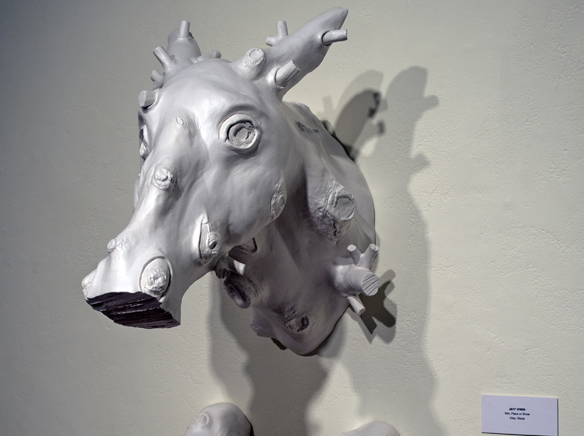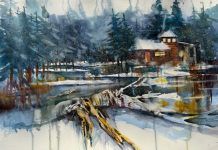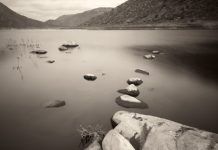Ceramicist Jeff Irwin and photographer Suda House, both members of the Grossmont College faculty, are among eight San Diego County artists whose works are now on display through March 29 in the Ninth Floor Gallery of the new Central Library in downtown San Diego.
Ceramicist Jeff Irwin and photographer Suda House, both members of the Grossmont College faculty, are among eight San Diego County artists whose works are now on display through March 29 in the Ninth Floor Gallery of the new Central Library in downtown San Diego.
Kathryn Kanjo, curator of the Museum of Contemporary Art San Diego, for the exhibit, which opened Sept. 30, selected their works, the same day the new Central Library at 330 Park Boulevard was opened to the public. Kanjo reviewed works from 125 exhibitions that had been displayed at the Central Library’s previous site since 1997.
“It’s quite an honor for Grossmont College that our faculty members comprise fully one-fourth of the exhibitors selected for this inaugural event at the Central Library,” commented Steve Baker, Dean of Arts, Languages and Communication. “Suda and Jeff not only are widely admired artists but also are highly rated faculty members, who have inspired legions of students.”
House utilized the technique known in French as trompe l’oeil (fool the eye) to create an image on cloth of other fabrics. She related in an interview that when she was in New York City on sabbatical leave, she went to various museums and galleries for research, “and we were coming back to the hotel and there were these three large dumpsters with sheets and towels and blankets just draping over them in the late afternoon light. I photographed them, and printed them on poly-silk, which is coated with ink jet receptors, and so it looks like fabric.”
House’s titled her eight-photograph combination “Sanctuary,” explaining that people of her grandmother’s age would sometimes use such expressions as “I can’t handle it anymore; I am going to my bed.” In the 19th century, House added, “they ‘swooned,’ or they ‘succumbed to the vapors’” and so beds were construed as places of sanctuary from the troubles of the world. “I saw this fabric that way,” she said.
Having not one, but eight, pieces in the exhibition allows viewers to see a body of work, “which I think is always a compliment because you can see vision and craft and progression,” House said. “A single piece may not convey that, but in a series you can be pretty confident about the objective of the artist.”
For House, the objective is to take photography beyond the realm of being documents or memories or impressions and to create instead art works that “bypass your brain and go right to your heart. So I am trying real hard to make looking at my work an experience.”
Jeff Irwin sculpts large animals from clay utilizing a process that makes the ceramic appear like wood. Sometimes the animals look as if they are leaping through the wall on which they are mounted, and other times they resemble hunters’ trophies. But when you look more closely, you realize that these animals also resemble the limbs and trunks of trees. One form of nature has morphed into another.
In the inaugural exhibition at the new Central Library, Irwin’s work is represented by a large white bear and an elephant trophy.
Clearly Irwin loves animals, but the subtext of his art is that trees, too, are an important component of nature, and that, like animals, trees also should be conserved. The ceramic sculptures are painted white because “I really love the subtlety of white, how it plays with light. It is very soft, quiet, and has just a little bit of a sheen. It is like a skin or a hide, and the pieces are meant to look extremely realistic.”
Irwin sketches animals-cum-trees regularly and then tests his ideas by creating tiny finger-sized sculptures in modeling clay. If he likes the miniature, he then will spread over his table photographs of the animals culled from his own photography as well as from magazines and the Internet. Using such materials, he will create a larger piece, typically building it in sections for the very practical reason that his kiln measures only 29 by 32 inches.
The sculptor likes to take impressions of knot holes and patterns he finds on bark. He will slap clay onto a tree to take an impression, pull it off and let it dry, and then fire it to make a mold.
“Then all I have to do is press clay into that form and I get a perfect rendition of that image,” he said. “When I place it, it is compositional. A space here, a pattern there, it’s in the way I place them. It is all about composition.”
He added that “I don’t want to destroy the sense of the animal, but I also want it to look like a tree, so I work back and forth between them. I spend hours and hours on them.”
For Irwin, nature is “my place of solace.” When he was growing up as a surfer in Southern California, the beach was his place. Later he went to college in Arcata, near the California-Oregon border, and his major was art, his minor was environmental science.
He used to like to run among the redwoods near the campus, “but if you ran far enough you would come to the clear-cut area where the redwoods had just been leveled. I saw a space of solace being torn down, and I think it just stuck with me. Preservation is something that I continue to want to speak about through my art.”














